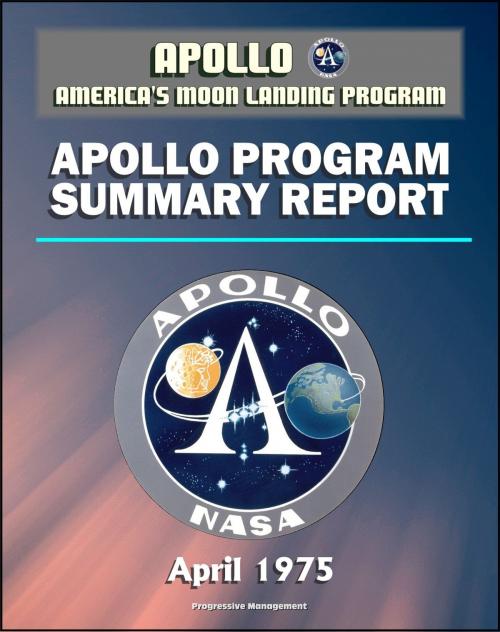Apollo and America's Moon Landing Program: Apollo Program Summary Report (April 1975) - Flight Program, Science, Vehicle Performance, Crew, Mission Operations, Biomedical, Spacecraft, Launch Site
Nonfiction, Science & Nature, Science, Physics, Astronomy, History, Americas| Author: | Progressive Management | ISBN: | 9781465928818 |
| Publisher: | Progressive Management | Publication: | December 8, 2011 |
| Imprint: | Smashwords Edition | Language: | English |
| Author: | Progressive Management |
| ISBN: | 9781465928818 |
| Publisher: | Progressive Management |
| Publication: | December 8, 2011 |
| Imprint: | Smashwords Edition |
| Language: | English |
This comprehensive official NASA history document - converted for accurate flowing-text e-book format reproduction - is the authoritative post-program summary document for the Apollo moon landing project, produced in 1975 by the Johnson Space Center (JSC).
From the Foreword: "This report is intended to summarize the major activities of Apollo and to provide sources of reference for those who desire to pursue any portion to a greater depth." The introduction states: "The Apollo Program Summary Report is a synopsis of the overall program activities and the technology developed to accomplish lunar exploration. The report is intended, primarily, for the reader who desires a general knowledge of the technical aspects of the Apollo program, but was also edited for comprehension by the lay reader. Much of the information contained herein has been extracted or summarized from Apollo Mission Reports, Apollo Preliminary Science Reports, Apollo Experience Reports, and other applicable documents. However, some of the information has not been published elsewhere. A summary of the flights conducted over an 11-year period is followed by specific aspects of the overall program, including lunar science, vehicle development, flight operations, and biomedical results. No attempt was made to include information pertaining to the management of the Apollo program since this area deserves special treatment. Several other areas were also considered to be beyond the scope of this document, although they were of great importance in accomplishing the established program objectives."
Contents: INTRODUCTION * FLIGHT PROGRAM * SCIENCE SUMMARY * VEHICLE DEVELOPMENT AND PERFORMANCE * SPACECRAFT DEVELOPMENT TESTING * FLIGHT CREW SUMMARY * MISSION OPERATIONS * BIOMEDICAL SUMMARY * SPACECRAFT MANUFACTURING AND TESTING * LAUNCH SITE FACILITIES, EQUIPMENT, AND PRELAUNCH OPERATIONS * LUNAR RECEIVING LABORATORY
The Apollo program consisted of 33 flights, 11 of which were manned. The 22 unmanned flights were conducted to qualify the launch vehicle and spacecraft for manned space flight. Four of the manned flights were also conducted to nan-rate the overall vehicle for lunar exploration. The final seven flights were conducted to explore the lunar environment and surface, providing man with detailed data concerning the moon and its characteristics.
Especially significant during the Apollo program was that no major launch vehicle failure occurred to prevent a mission from being accomplished and only one inflight failure of a spacecraft (Apollo 13) prevented the intended mission from being accomplished.
This comprehensive official NASA history document - converted for accurate flowing-text e-book format reproduction - is the authoritative post-program summary document for the Apollo moon landing project, produced in 1975 by the Johnson Space Center (JSC).
From the Foreword: "This report is intended to summarize the major activities of Apollo and to provide sources of reference for those who desire to pursue any portion to a greater depth." The introduction states: "The Apollo Program Summary Report is a synopsis of the overall program activities and the technology developed to accomplish lunar exploration. The report is intended, primarily, for the reader who desires a general knowledge of the technical aspects of the Apollo program, but was also edited for comprehension by the lay reader. Much of the information contained herein has been extracted or summarized from Apollo Mission Reports, Apollo Preliminary Science Reports, Apollo Experience Reports, and other applicable documents. However, some of the information has not been published elsewhere. A summary of the flights conducted over an 11-year period is followed by specific aspects of the overall program, including lunar science, vehicle development, flight operations, and biomedical results. No attempt was made to include information pertaining to the management of the Apollo program since this area deserves special treatment. Several other areas were also considered to be beyond the scope of this document, although they were of great importance in accomplishing the established program objectives."
Contents: INTRODUCTION * FLIGHT PROGRAM * SCIENCE SUMMARY * VEHICLE DEVELOPMENT AND PERFORMANCE * SPACECRAFT DEVELOPMENT TESTING * FLIGHT CREW SUMMARY * MISSION OPERATIONS * BIOMEDICAL SUMMARY * SPACECRAFT MANUFACTURING AND TESTING * LAUNCH SITE FACILITIES, EQUIPMENT, AND PRELAUNCH OPERATIONS * LUNAR RECEIVING LABORATORY
The Apollo program consisted of 33 flights, 11 of which were manned. The 22 unmanned flights were conducted to qualify the launch vehicle and spacecraft for manned space flight. Four of the manned flights were also conducted to nan-rate the overall vehicle for lunar exploration. The final seven flights were conducted to explore the lunar environment and surface, providing man with detailed data concerning the moon and its characteristics.
Especially significant during the Apollo program was that no major launch vehicle failure occurred to prevent a mission from being accomplished and only one inflight failure of a spacecraft (Apollo 13) prevented the intended mission from being accomplished.















